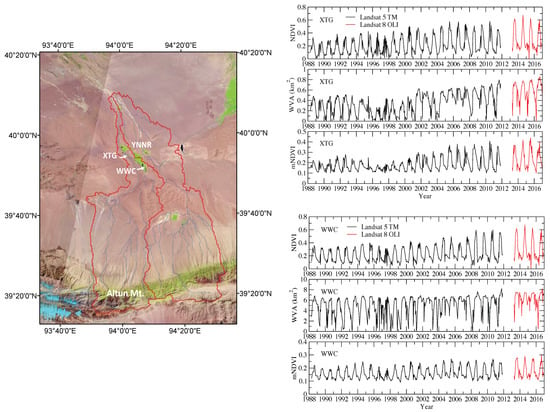Evaluation of Climate Change Impacts on Wetland Vegetation in the Dunhuang Yangguan National Nature Reserve in Northwest China Using Landsat Derived NDVI
Abstract
:1. Introduction
2. Study Area and Data
2.1. Study Area
2.2. Meteorological Data
2.3. The Hydrologic Regime of the YNNR
2.4. Landsat Imagery
3. Methods
3.1. Computing the Normalized Difference Vegetation Index (NDVI)
3.2. Trend and Correlation Analyses
4. Results and Discussion
4.1. Climatic Characteristics of the YNNR
4.2. Climate Change in the YNNR
4.3. Analysis of the Landsat Derived NDVIs of the Wetland Vegetation in the YNNR
4.4. Climate Change Impacts on the Wetland Vegetation in the YNNR
5. Conclusions
Author Contributions
Acknowledgments
Conflicts of Interest
References
- Bradley, R.S. Past global changes and their significance for the future. Quat. Sci. Rev. 2000, 19, 391–402. [Google Scholar] [CrossRef]
- Bradley, R.S. 1000 years of climate change. Science 2000, 288, 1353–1355. [Google Scholar] [CrossRef]
- Luterbacher, J.; Dietrich, D.; Xoplaki, A.E.; Grosjean, M.; Wanner, H. European seasonal and annual temperature variability, trends, and extremes since 1500. Science 2004, 303, 1499–1503. [Google Scholar] [CrossRef] [PubMed]
- O’Gorman, P.A.; Schneider, A. The physical basis for increases in precipitation extremes in simulations of 21st-century climate change. Proc. Natl. Acad. Sci. USA 2009, 106, 14773–14777. [Google Scholar] [CrossRef] [PubMed]
- Trenberth, K.E. Attribution of climate variations and trends to human influences and natural variability. Wiley Interdiscip. Rev. Clim. Chang. 2011, 2, 925–930. [Google Scholar] [CrossRef]
- Walther, G.R.; Post, E.; Convey, P.; Menzel, A.; Parmesan, C.; Beebee, T.J.; Fromentin, J.M.; Hoegh-Guldberg, O.; Bairlein, F. Ecological responses to recent climate change. Nature 2002, 416, 389–395. [Google Scholar] [CrossRef] [PubMed]
- Frich, P.; Alexander, L.V.; Della-Marta, D.; Gleason, B.; Haylock, M.; Klein Tank, A.M.G.; Pelerson, T. Observed coherent changes in climatic extremes during the second half of the twentieth century. Clim. Res. 2002, 19, 193–212. [Google Scholar] [CrossRef]
- Wentz, F.J.; Ricciardulli, L.; Hilburn, K.; Mears, C. How much more rain will global warming bring? Science 2007, 317, 233–235. [Google Scholar] [CrossRef] [PubMed]
- Dore, M.H. Climate change and changes in global precipitation patterns: What do we know? Environ. Int. 2005, 31, 1167–1181. [Google Scholar] [CrossRef] [PubMed]
- Erwin, K.L. Wetlands and global climate change: The role of wetland restoration in a changing world. Wetl. Ecol. Manag. 2009, 17, 71–84. [Google Scholar] [CrossRef]
- Scavia, D.; Field, J.C.; Boesch, D.F.; Buddemeier, R.W.; Burkett, V.; Cayan, D.R.; Fogarty, M.; Harwell, M.A.; Howarth, R.W.; Mason, C.; et al. Climate change impacts on U.S. coastal and marine ecosystems. Estuaries 2002, 25, 149–164. [Google Scholar] [CrossRef]
- Burkett, V.; Kusler, J. Climate change: Potential impacts and interactions in wetlands of the United States. J. Am. Water Resour. Assoc. 2000, 36, 313–320. [Google Scholar] [CrossRef]
- Adam, E.; Mutanga, O.; Rugege, D. Multispectral and hyperspectral remote sensing for identification and mapping of wetland vegetation: A review. Wetl. Ecol. Manag. 2010, 18, 281–296. [Google Scholar] [CrossRef]
- Silva, T.S.; Costa, M.P.; Melack, J.M.; Novo, E.M. Remote sensing of aquatic vegetation: Theory and applications. Environ. Monit. Assess. 2008, 140, 131–145. [Google Scholar] [CrossRef] [PubMed]
- Mutanga, O.; Adam, E.; Cho, M.A. High density biomass estimation for wetland vegetation using WorldView-2 imagery and random forest regression algorithm. Int. J. Appl. Earth Obs. Geoinf. 2012, 18, 399–406. [Google Scholar] [CrossRef]
- Owino, A.O.; Ryan, P.G. Recent papyrus swamp habitat loss and conservation implications in western Kenya. Wetl. Ecol. Manag. 2007, 15, 1–12. [Google Scholar] [CrossRef]
- Huang, J.; Wang, S.; Yan, L.; Zhong, Q. Plant photosynthesis and its influence on removal efficiencies in constructed wetlands. Ecol. Eng. 2010, 36, 1037–1043. [Google Scholar] [CrossRef]
- Rouse, J.W.; Haas, R.H.; Schell, J.A.; Deering, D.W. Monitoring vegetation systems in the Great Plains with ERTS. In Proceedings of the 3rd Earth Resource Technology Satellite (ERTS) Symposium, Washington, DC, USA, 10–14 December 1973; Scientific and Technical Information Office, National Aeronautics and Space Administration: Washington, DC, USA, 1974; Volume 1, pp. 48–62. [Google Scholar]
- Deering, D.W.; Rouse, J.W.; Haas, R.H.; Schell, J.A. Measuring forage production of grazing units from Landsat MSS data. In Proceedings of the 10th International Symposium on Remote Sensing of Environment; University of Michigan: Ann Arbor, MI, USA, 1975; pp. 1169–1178. [Google Scholar]
- Deering, D.W. Rangeland Reflectance Characteristics Measured by Aircraft and Spacecraft Sensors. Ph.D. Dissertation, Texas A&M University, College Station, TX, USA, 1978; 338p. [Google Scholar]
- Pettorelli, N.; Vik, J.O.; Mysterud, A.; Gaillard, J.; Tucker, C.J.; Stenseth, N.C. Using the satellite-derived NDVI to assess ecological responses to environmental change. Trends Ecol. Evol. 2005, 20, 503–510. [Google Scholar] [CrossRef] [PubMed]
- Peruelo, J.M.; Lauenroth, W.K. Inter-annual variability of NDVI and its relationship to climate for North American shrublands and grasslands. J. Biogeogr. 1998, 25, 721–733. [Google Scholar] [CrossRef]
- Forkel, M.; Carvalhais, N.; Verbesselt, J.; Mahecha, M.D.; Neigh, C.S.R.; Reichstein, M. Trend change detection in NDVI time series: Effects of inter-annual; variability and methodology. Remote Sens. 2013, 5, 2113–2144. [Google Scholar] [CrossRef]
- Eastman, J.R.; Sangermano, F.; Machado, E.A.; Rogan, J.; Anyamba, A. Global trends in seasonality of normalized difference vegetation index (NDVI), 1982–2011. Remote Sens. 2013, 5, 4799–4818. [Google Scholar] [CrossRef]
- Bhatt, U.; Walker, D.A.; Raynolds, M.K.; Bieniek, P.A.; Epstein, H.E.; Comiso, J.C.; Pinzon, J.Z.; Tucker, C.J.; Polyakov, I.V. Recent declines in warming and vegetation greening trends over Pan-Arctic Tundra. Remote Sens. 2013, 5, 4229–4254. [Google Scholar] [CrossRef]
- Mao, J.; Shi, X.; Thorton, P.E.; Hoffman, F.M.; Zhu, Z.C.; Myneni, R.B. Global latitudinal-asymmetric vegetation growth trends and their driving mechanisms: 1982–2009. Remote Sens. 2013, 5, 1484–1497. [Google Scholar] [CrossRef]
- Kariyeva, J.; van Leeuwen, W.J.D. Environmental drivers of NDVI-based vegetation phenology in Central Asia. Remote Sens. 2011, 3, 203–246. [Google Scholar] [CrossRef]
- Xu, G.; Zhang, H.; Chen, B.; Zhang, H.; Innes, J.L.; Wang, G.; Yan, J.; Zheng, Y.; Zhu, Z.; Myneni, R.B. Changes in vegetation growth dynamics and relations with climate over China’s landmass from 1982 to 2011. Remote Sens. 2014, 6, 3263–3283. [Google Scholar] [CrossRef]
- Bi, J.; Xu, L.; Samanta, A.; Zhu, Z.; Myneni, R. Divergent Arctic-Boreal vegetation changes between North America and Eurasia over the past 30 years. Remote Sens. 2013, 5, 2093–2112. [Google Scholar] [CrossRef]
- Li, Z.; Guo, X. Detecting climate effects on vegetation in northen mixed prairie using NOAA AVHRR 1-km time series NDVI data. Remote Sens. 2012, 4, 120–134. [Google Scholar] [CrossRef]
- Liu, Y.; Li, Y.; Li, S.; Motesharrei, S. Spatial and temporal patterns of global NDVI trends: Correlations with climate and human factors. Remote Sens. 2015, 7, 13233–13250. [Google Scholar] [CrossRef]
- Zhou, Y.; Zhang, L.; Fensholt, R.; Wang, K.; Vitkovskaya, I.; Tian, F. Climate contributions to vegetation variations in Central Asian Drylands: Pre-and Post-USSR collapse. Remote Sens. 2015, 7, 2449–2470. [Google Scholar] [CrossRef]
- Bao, G.; Qin, Z.; Bao, Y.; Zhou, Y.; Li, W.; Sanjjav, A. NDVI-based long-term vegetation dynamics and its response to climatic change in the Mongolian Plateau. Remote Sens. 2014, 6, 8337–8358. [Google Scholar] [CrossRef]
- He, B.; Chen, A.; Wang, H.; Wang, Q. Dynamic response of satellite-derived vegetation growth to climate change in the Three North Shelter Forest region in China. Remote Sens. 2015, 7, 9998–10016. [Google Scholar] [CrossRef]
- Li, S.; Yang, S.; Liu, X.; Liu, Y.; Shi, M. NDVI-based analysis on the influence of climate change and human activities on vegetation restoration in the Shaanxi-Gansu-Ningxia Region, Central China. Remote Sens. 2015, 7, 11163–11182. [Google Scholar] [CrossRef]
- Cai, H.; Yang, Y.; Wang, K.; Xiao, J. Is forest restoration in the Southwest China karst promoted mainly by climate change or human induced factors? Remote Sens. 2014, 6, 9895–9910. [Google Scholar] [CrossRef]
- Liu, X.; Zhu, X.; Li, S.; Liu, Y.; Pan, Y. Changes in growing season vegetation and their associated driving forces in China during 2001–2012. Remote Sens. 2015, 7, 15517–15535. [Google Scholar] [CrossRef]
- Hou, W.; Gao, J.; Wu, S.; Dai, E. Interannual variations in growing–season NDVI and its correlation with climate variables in the southwest karst region of China. Remote Sens. 2015, 7, 11105–11124. [Google Scholar] [CrossRef]
- Zhang, R.; Ouyang, Z.; Xie, X.; Guo, H.; Tan, D.; Xiao, X.; Qi, J.; Zhao, B. Impact of climate change on vegetation growth in arid northwest of China from 1982 to 2011. Remote Sens. 2016, 8. [Google Scholar] [CrossRef]
- Gao, Q.; Schwartz, M.; Zhu, W.; Wan, Y.; Qing, X.; Ma, X.; Liu, S.; Williamson, M.A.; Peters, C.B.; Li, Y. Changes in global grassland productivity during 1982 to 2011 attributable to climatic factors. Remote Sens. 2016, 8. [Google Scholar] [CrossRef]
- Huang, K.; Zhang, Y.; Zhu, J.; Liu, Y.; Zu, J.; Zhang, J. The influence of climate change and human activities on vegetation dynamics in the Qinghai-Tibet Plateau. Remote Sens. 2016, 8. [Google Scholar] [CrossRef]
- Tang, B.; Wu, D.; Zhao, X.; Zhou, T.; Zhao, W.; Wei, H. The observed impacts of wind farms on local vegetation growth in northern China. Remote Sens. 2017, 9. [Google Scholar] [CrossRef]
- Xia, G.; Zhou, L. Detecting wind farm impacts on local vegetation growth in Texas and Illinois using MODIS vegetation greenness measurements. Remote Sens. 2017, 9. [Google Scholar] [CrossRef]
- Brown, R.D.; Brasnett, B. Canadian Meteorological Centre (CMC) Daily Snow Depth Analysis Data, 2017, Version 1; NASA National Snow and Ice Data Center Distributed Active Archive Center: Boulder, CO, USA, 2017.
- Chander, G.; Markham, B.L.; Helder, D.L. Summary of current radiometric calibration coefficients for Landsat MSS < TM, ETM+, and EO-1 ALIO sensors. Remote Sens. Environ. 2009, 113, 893–903. [Google Scholar]
- Roy, D.P.; Kovalskyy, V.; Zhang, H.K.; Vermote, E.F.; Yan, L.; Kumar, S.S.; Egorov, A. Characterization of Landsat-7 to Landsat-8 reflective wavelength and normalized difference vegetation index continuity. Remote Sens. Environ. 2016, 185, 57–70. [Google Scholar] [CrossRef]
- IPCC. Climate Change 2013: The Physical Science Basis Technical Summary; Intergovernmental Panel on Climate Change: Geneva, Switzerland, 2013; 222p. [Google Scholar]
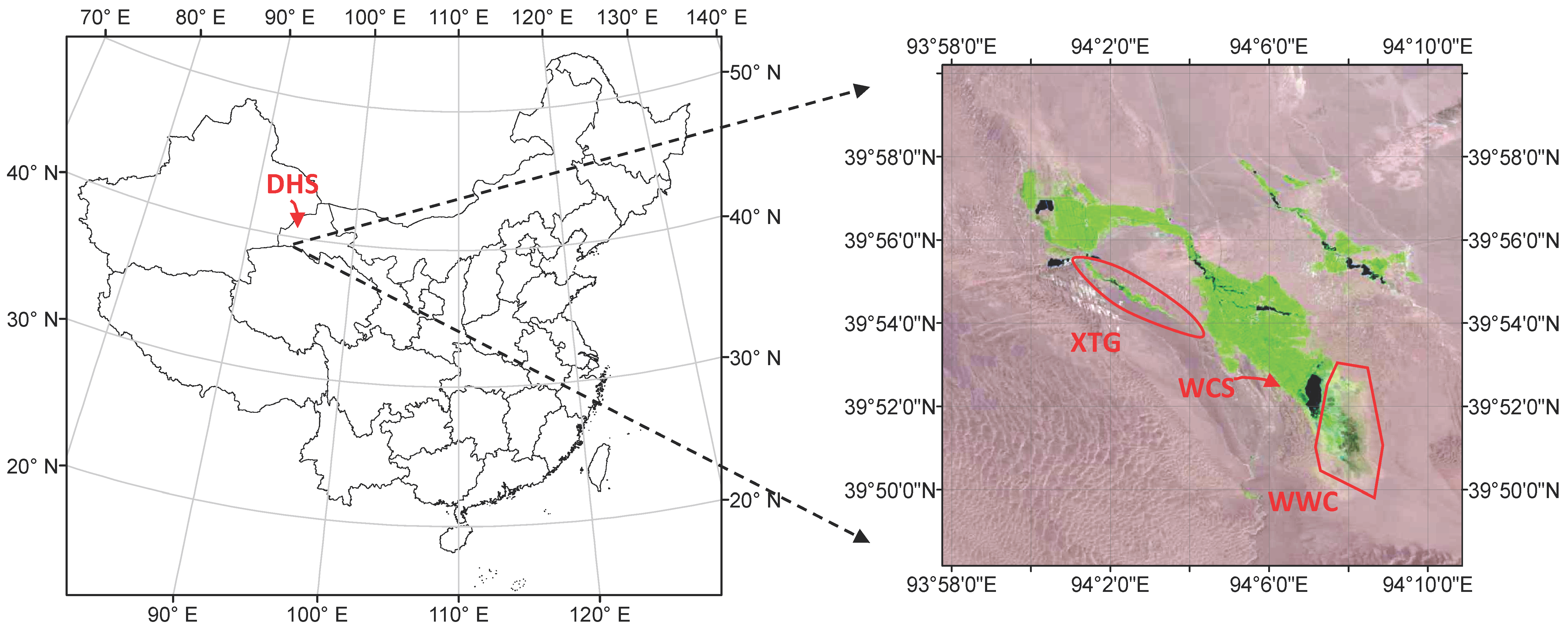
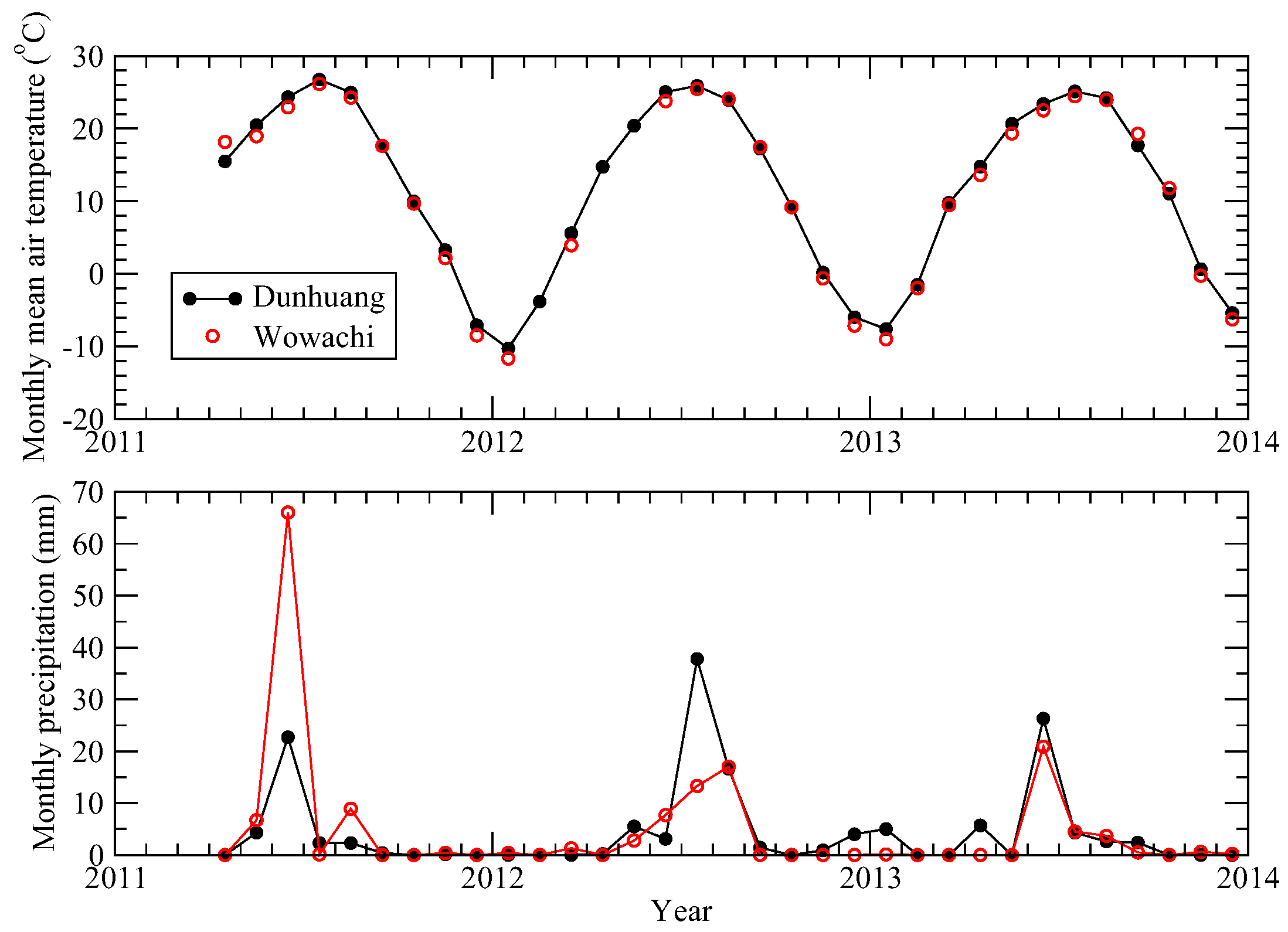
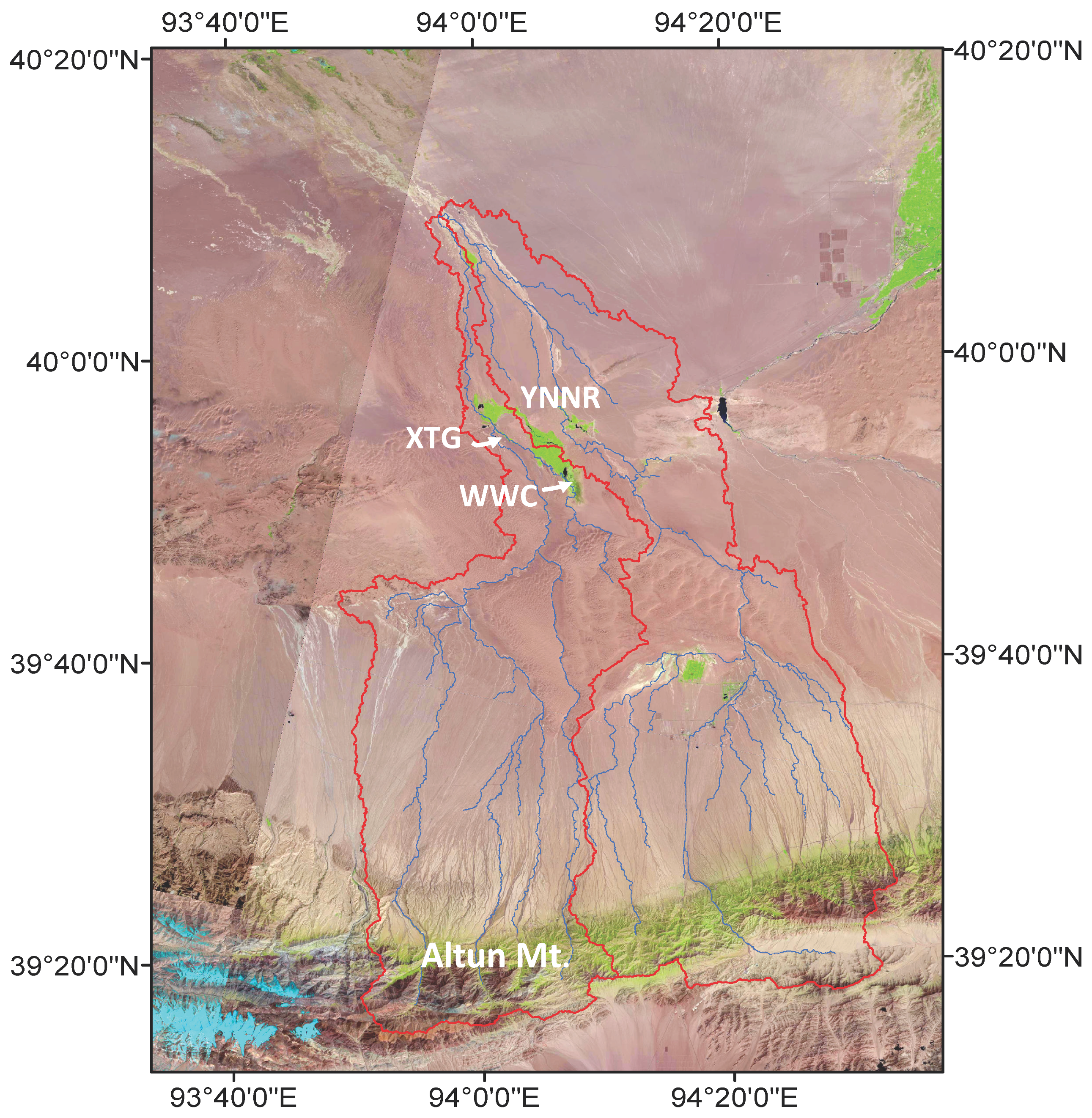

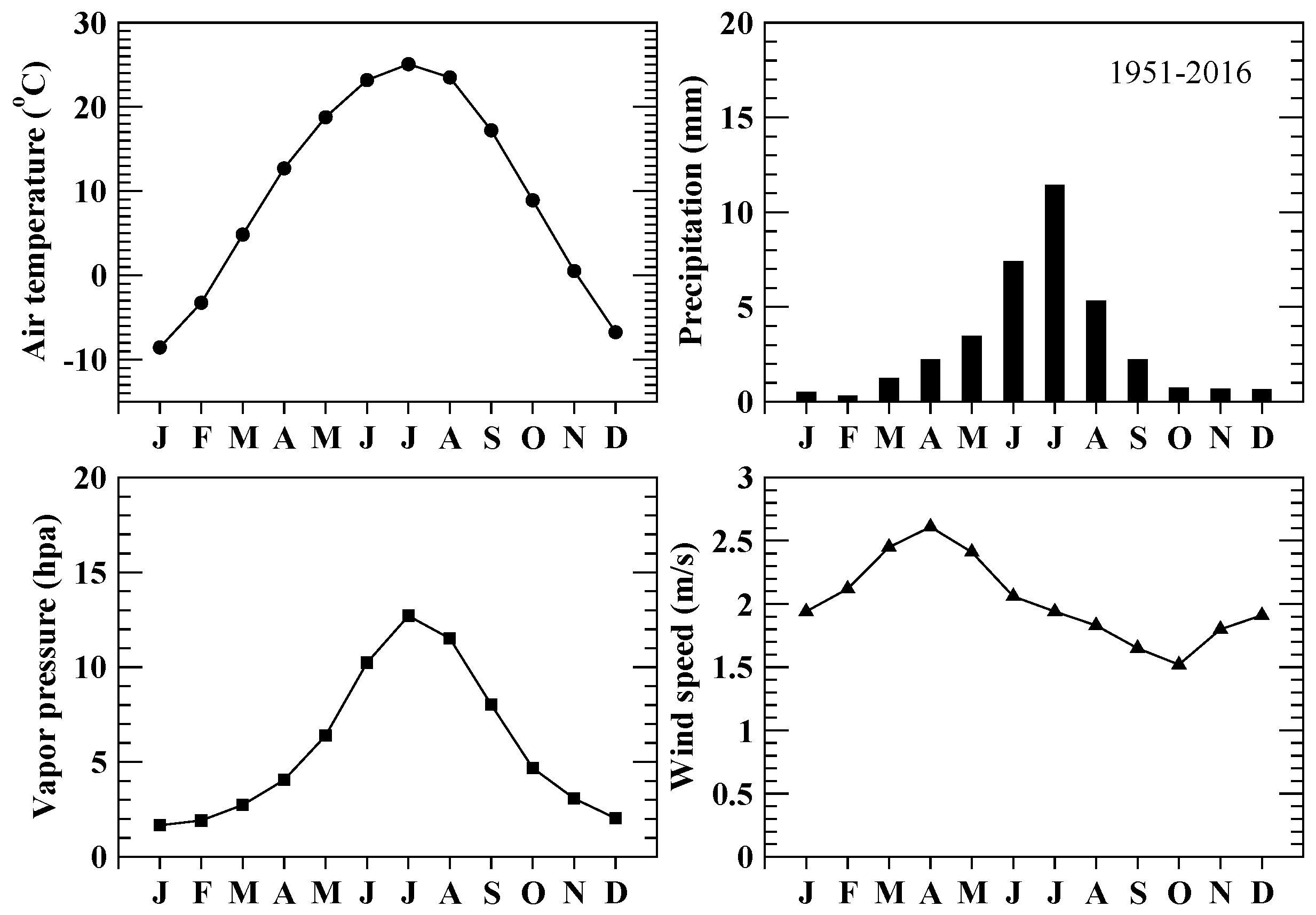

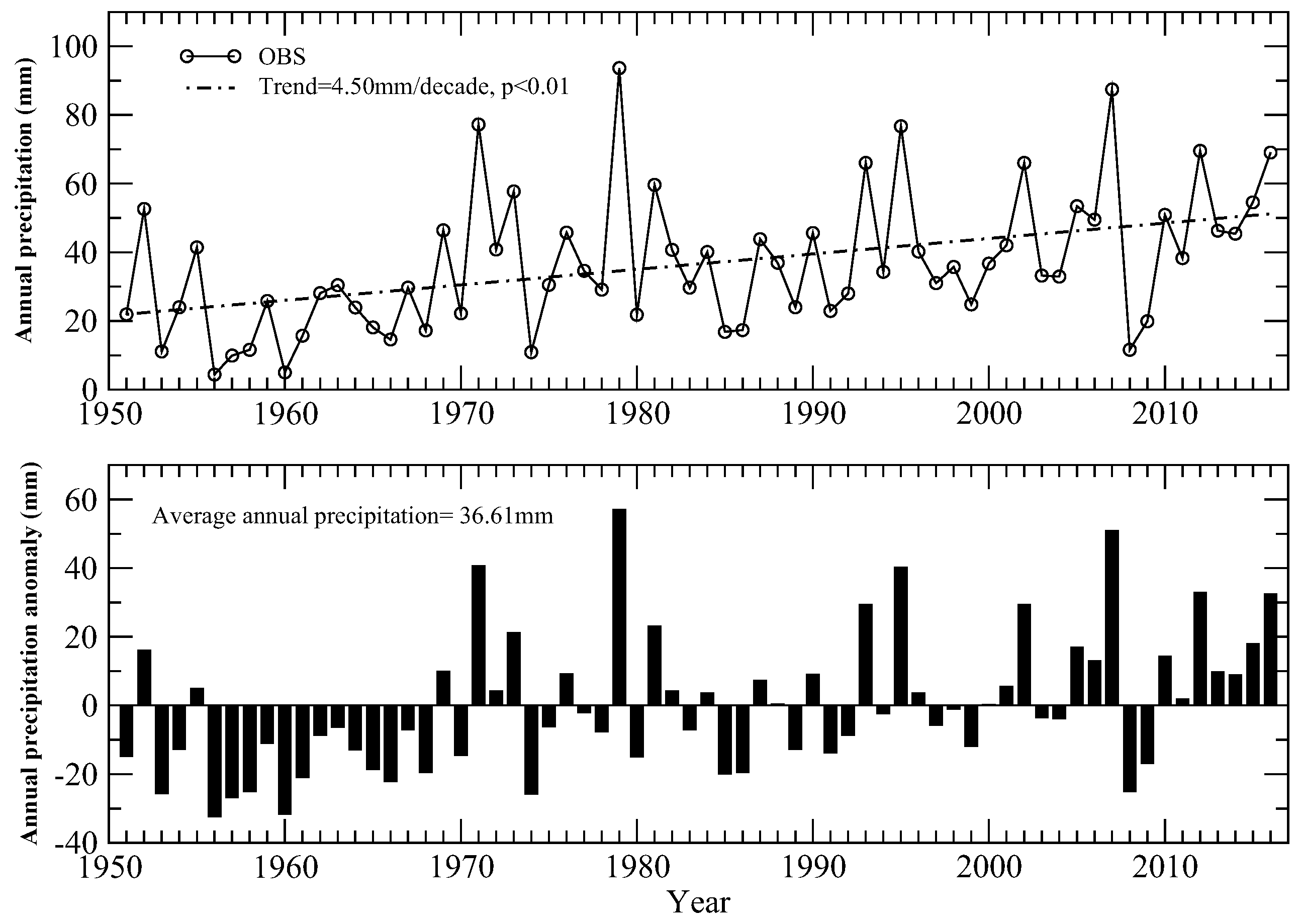
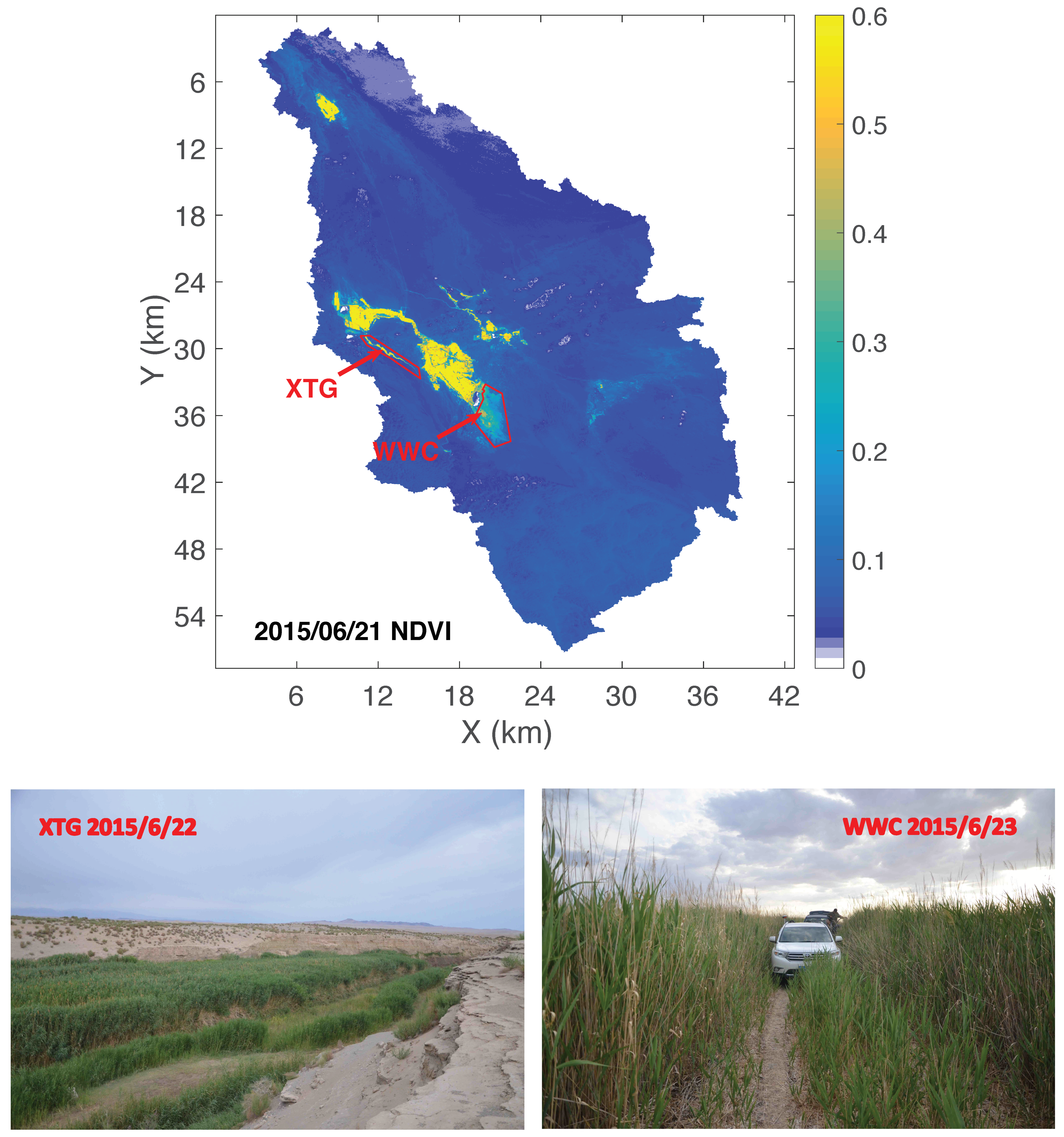
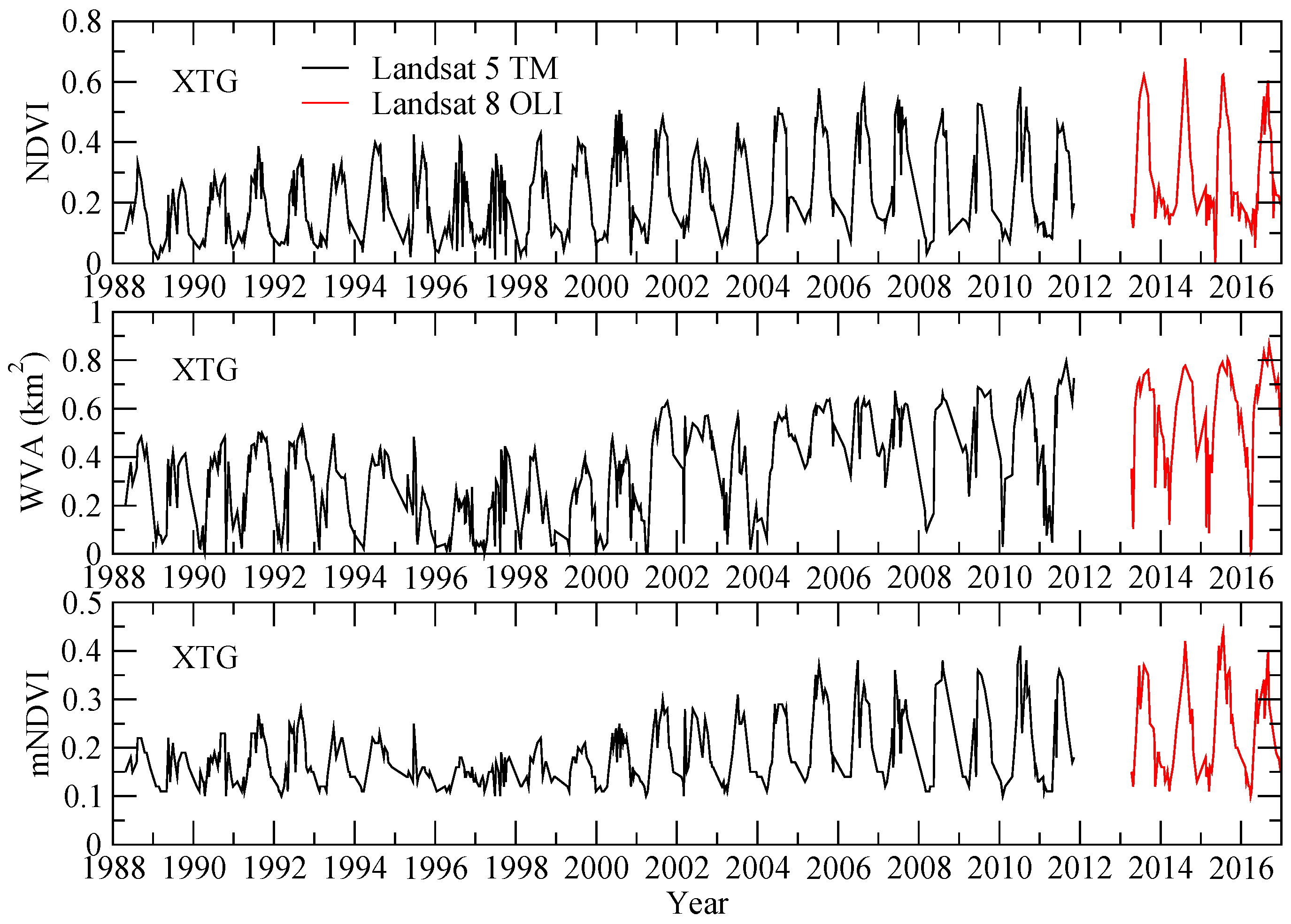
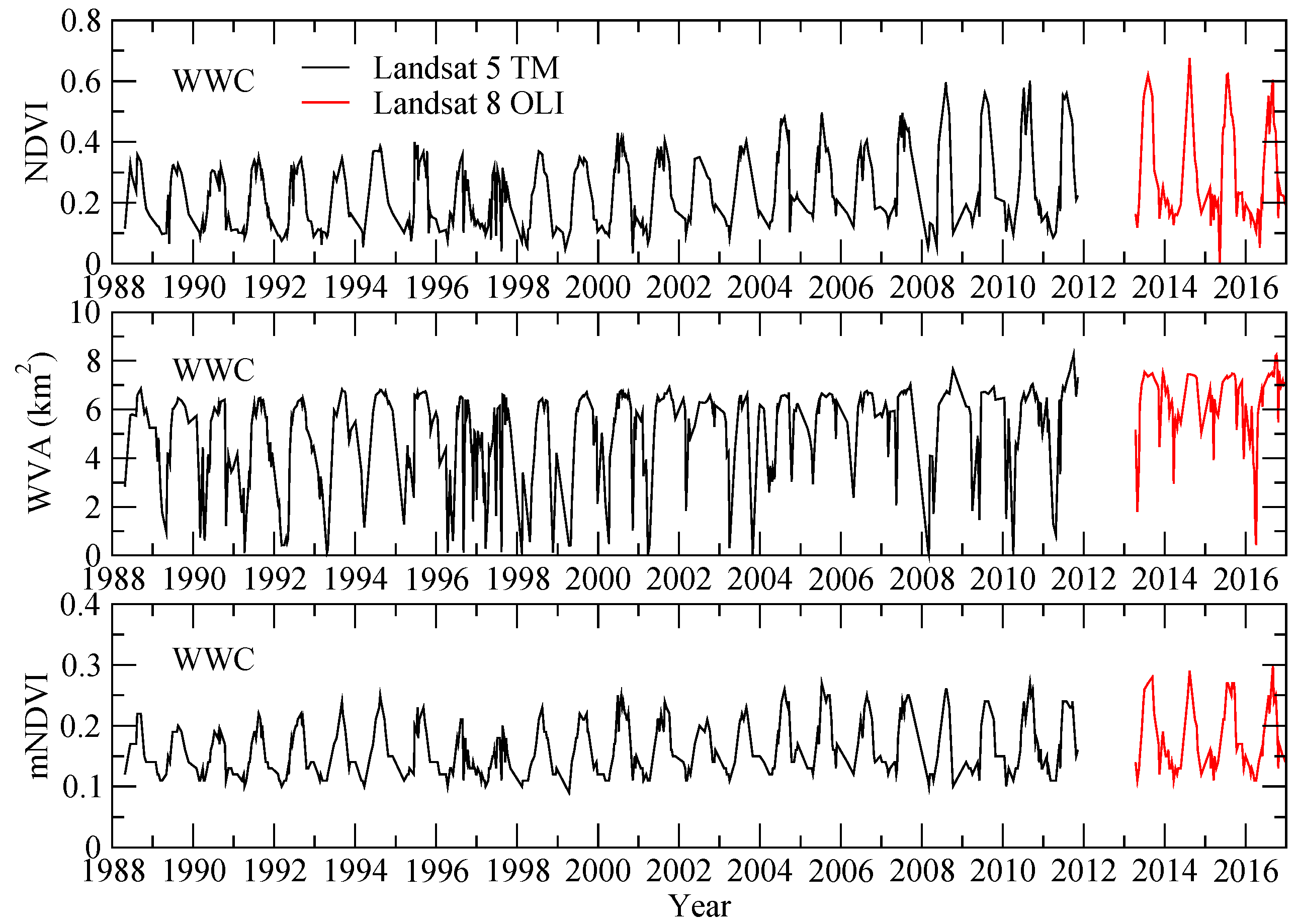
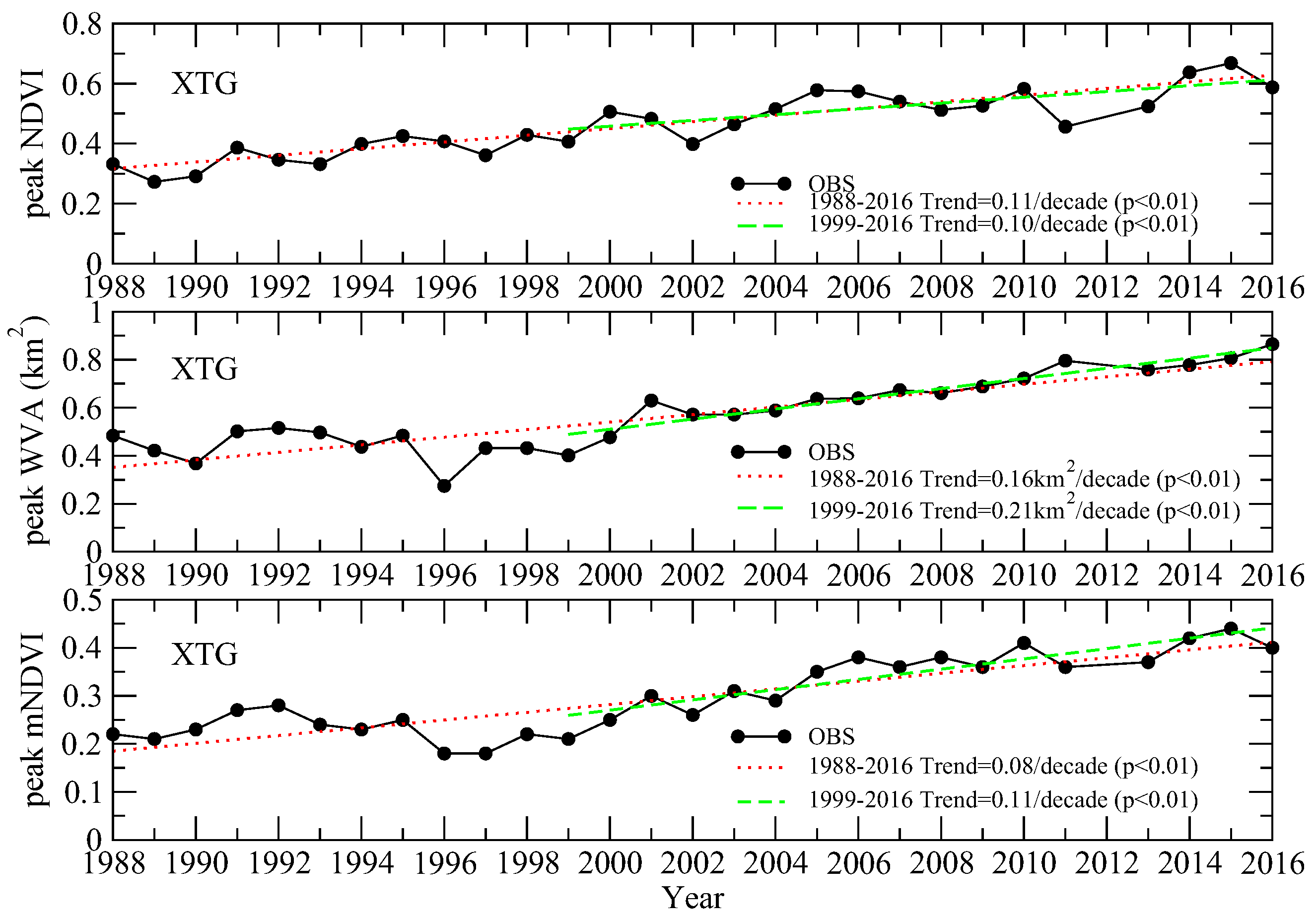
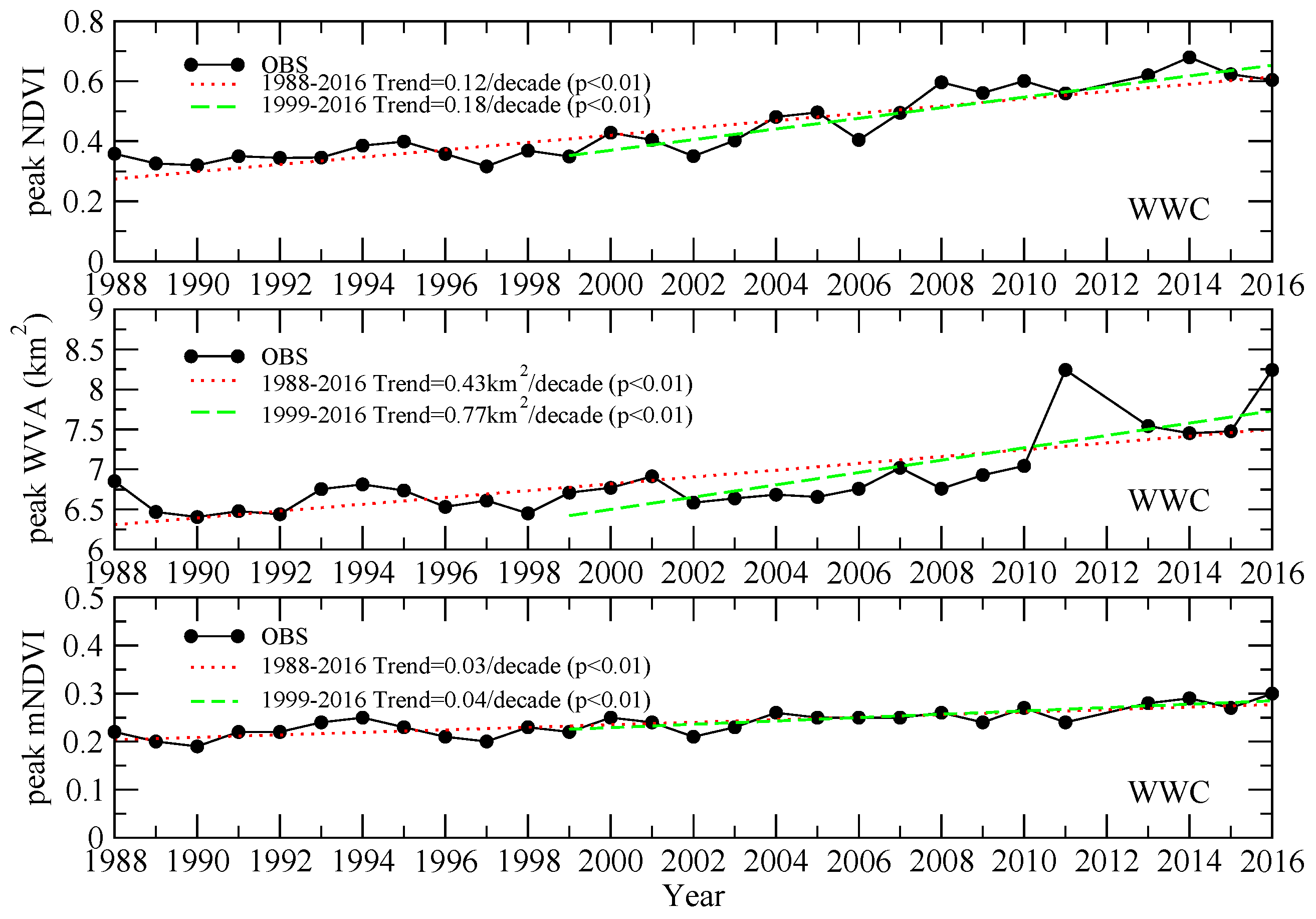
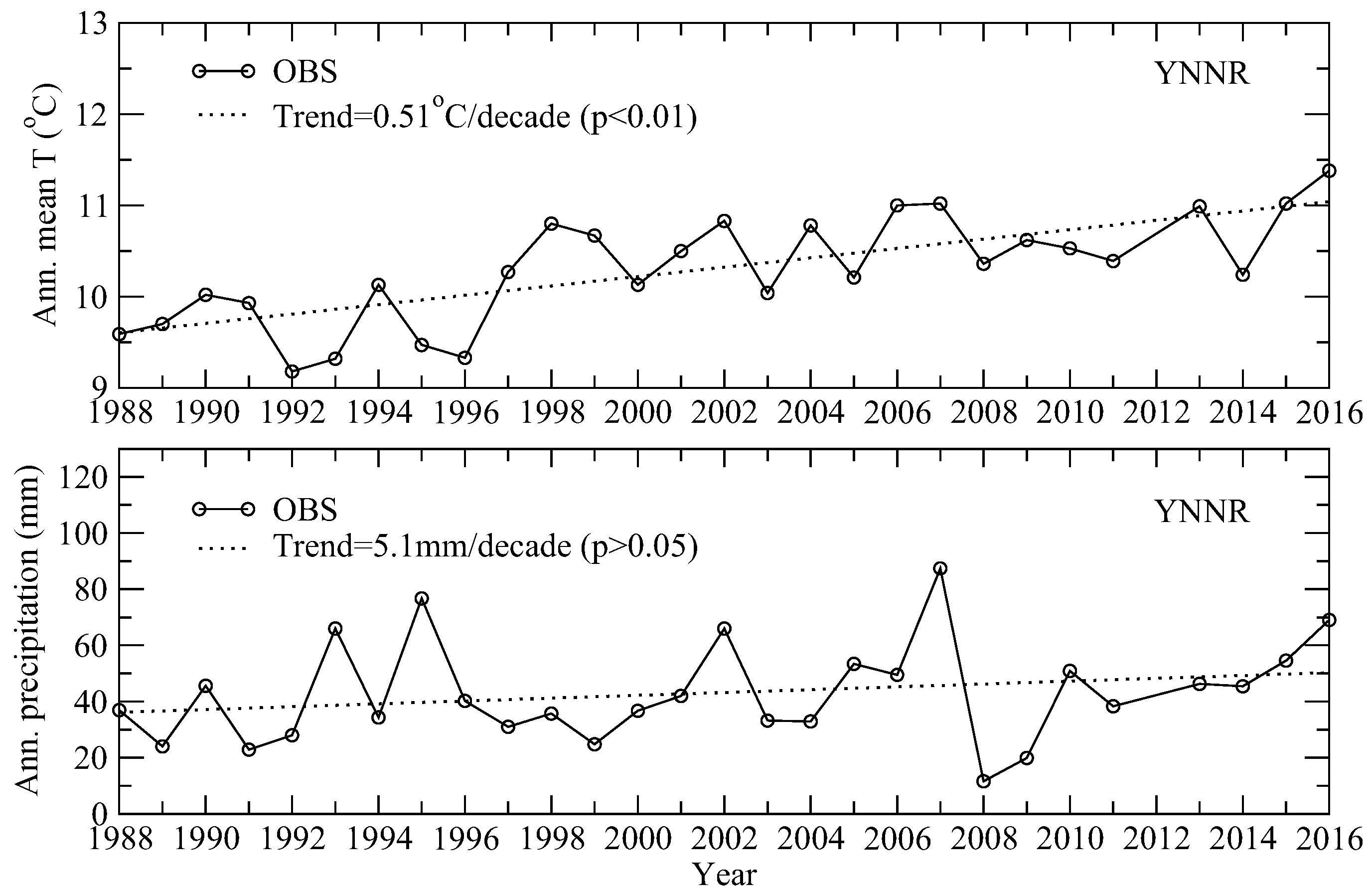
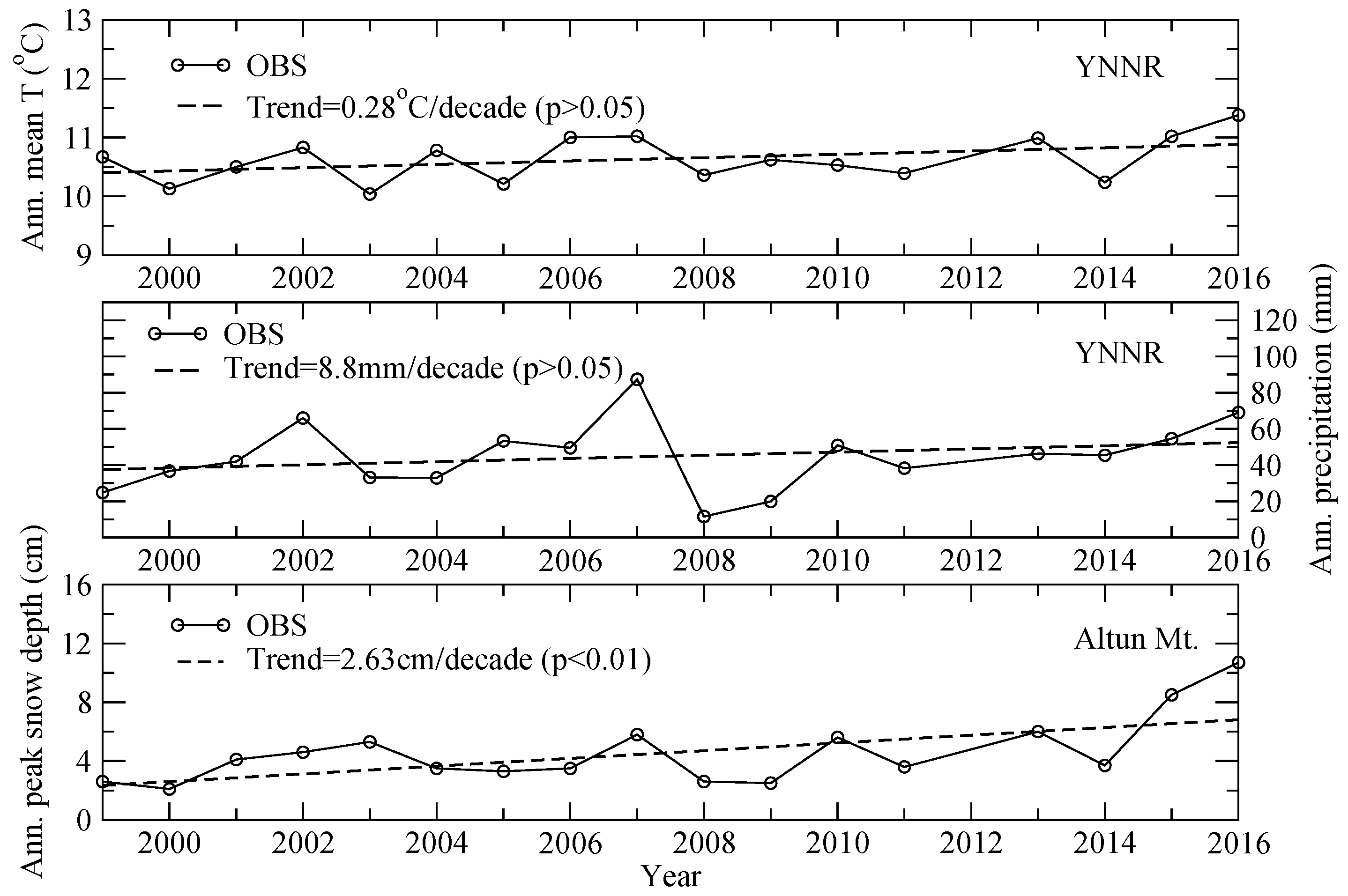
| Band | Landsat 5 TM | Landsat 8 OLI | ||
|---|---|---|---|---|
| Band Index | λ (μm) | Band Index | λ (μm) | |
| Red | Band 3 | 0.626–0.693 | Band 4 | 0.636–0.673 |
| NIR | Band 4 | 0.776–0.904 | Band 5 | 0.851–0.879 |
| Gλ (W/(m2 sr μm)) | Bλ (W/(m2 sr μm)) | |
|---|---|---|
| Band 3 | 1.043976 | −2.21 |
| Band 4 | 0.876024 | −2.39 |
| DOY | d | DOY | d | DOY | d | DOY | d |
|---|---|---|---|---|---|---|---|
| 1 | 0.9832 | 91 | 0.9993 | 196 | 1.0165 | 288 | 0.9972 |
| 15 | 0.9836 | 106 | 1.0033 | 213 | 1.0149 | 305 | 0.9925 |
| 32 | 0.9853 | 121 | 1.0076 | 227 | 1.0128 | 319 | 0.9892 |
| 46 | 0.9878 | 135 | 1.0109 | 242 | 1.0092 | 335 | 0.9860 |
| 60 | 0.9909 | 1521 | 1.0140 | 258 | 1.0057 | 349 | 0.9843 |
| 74 | 0.9945 | 166 | 1.0158 | 274 | 1.0011 | 365 | 0.9833 |
| Peak NDVI | Peak WVA | Peak mNDVI | ||||
|---|---|---|---|---|---|---|
| XTG | WWC | XTG | WWC | XTG | WWC | |
| T * | 0.65 (p < 0.01) | 0.53 (p < 0.01) | 0.62 (p < 0.01) | 0.51 (p < 0.01) | 0.56 (p < 0.01) | 0.54 (p < 0.01) |
| P * | 0.27 (p > 0.05) | 0.14 (p > 0.05) | 0.29 (p > 0.05) | 0.28 (p > 0.05) | 0.27 (p > 0.05) | 0.24 (p > 0.05) |
| Peak NDVI | Peak WVA | Peak mNDVI | ||||
|---|---|---|---|---|---|---|
| XTG | WWC | XTG | WWC | XTG | WWC | |
| T * | 0.21 (p < 0.05) | 0.13 (p > 0.05) | 0.38 (p > 0.05) | 0.36 (p > 0.05) | 0.25 (p > 0.05) | 0.31 (p > 0.05) |
| P * | 0.28 (p > 0.05) | 0.03 (p > 0.05) | 0.34 (p > 0.05) | 0.26 (p > 0.05) | 0.25 (p > 0.05) | 0.21 (p > 0.05) |
| S * | 0.49 (p < 0.05) | 0.42 (p < 0.05) | 0.64 (p < 0.01) | 0.59 (p < 0.05) | 0.50 (p < 0.05) | 0.54 (p < 0.05) |
© 2018 by the authors. Licensee MDPI, Basel, Switzerland. This article is an open access article distributed under the terms and conditions of the Creative Commons Attribution (CC BY) license (http://creativecommons.org/licenses/by/4.0/).
Share and Cite
Pan, F.; Xie, J.; Lin, J.; Zhao, T.; Ji, Y.; Hu, Q.; Pan, X.; Wang, C.; Xi, X. Evaluation of Climate Change Impacts on Wetland Vegetation in the Dunhuang Yangguan National Nature Reserve in Northwest China Using Landsat Derived NDVI. Remote Sens. 2018, 10, 735. https://doi.org/10.3390/rs10050735
Pan F, Xie J, Lin J, Zhao T, Ji Y, Hu Q, Pan X, Wang C, Xi X. Evaluation of Climate Change Impacts on Wetland Vegetation in the Dunhuang Yangguan National Nature Reserve in Northwest China Using Landsat Derived NDVI. Remote Sensing. 2018; 10(5):735. https://doi.org/10.3390/rs10050735
Chicago/Turabian StylePan, Feifei, Jianping Xie, Juming Lin, Tingwei Zhao, Yongyuan Ji, Qi Hu, Xuebiao Pan, Cheng Wang, and Xiaohuan Xi. 2018. "Evaluation of Climate Change Impacts on Wetland Vegetation in the Dunhuang Yangguan National Nature Reserve in Northwest China Using Landsat Derived NDVI" Remote Sensing 10, no. 5: 735. https://doi.org/10.3390/rs10050735
APA StylePan, F., Xie, J., Lin, J., Zhao, T., Ji, Y., Hu, Q., Pan, X., Wang, C., & Xi, X. (2018). Evaluation of Climate Change Impacts on Wetland Vegetation in the Dunhuang Yangguan National Nature Reserve in Northwest China Using Landsat Derived NDVI. Remote Sensing, 10(5), 735. https://doi.org/10.3390/rs10050735






